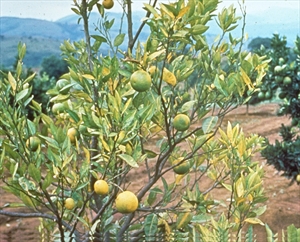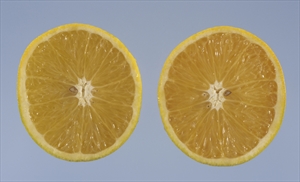- Worldwide distribution. In tropics and sub-tropics. On all species and varieties of citrus, and ornamentals, e.g., mock orange or orange jasmine and the curry tree. An important bacterial disease.
- Patches of yellow on leaves: (i) across veins, (ii) often on one side, (iii) on one shoot or one branch, (iii) seen mostly on newly hardened leaves, before fading.
- Spread by sap-sucking psyllids, and citrus plant trade.
- Within a year of infection, leaves fall, fruits are misshapen with uneven colour (bottom stays green), and trees dieback.
- Biosecurity: many countries are still vulnerable to the disease.
- Natural enemies: parasitoid wasp are known.
- Cultural control: nursery plant certification; monthly monitoring; removal of infected trees.
- Chemical control: use soap, white or horticultural oil sprays, or neem; use synthetic pyrethroids or imidacloprid. These treatments are to psyllid.








